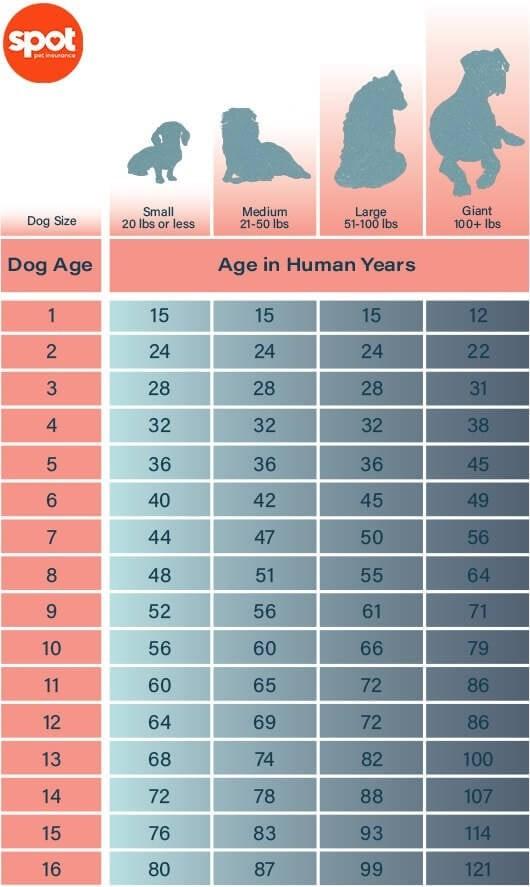We’ve all wondered how old our dogs are in human years at some point in time. There’s a common misconception that one dog year equals seven human years, but it’s actually a little more complicated than that! The aging process in dogs is unique in that the dog breed also impacts their lifespan, too. For example, small dogs tend to live longer lives than large dogs, making it a bit trickier to calculate their age matter-of-factly into human years.
To help you calculate dog years to human years, we at Spot have come up with a comprehensive guide to understanding your furry friend’s true age, including a chart to convert human years to determine your dog’s age.
What Factors Into My Dog’s Age?
Two main factors for dog age are size and breed. Many large dogs like great danes have a shorter life expectancy compared to smaller-sized breeds such as a Shih Tzus or Chihuahua. This is because their bodies metabolize food more efficiently, and given their size, are more adept at fighting free radicals and abnormal growths within the body.
Breed and size aside, dogs naturally age faster than humans. To get a more accurate read on a dog’s biological age (meaning, how “old” their body is functioning rather than their years alive since birth) some researchers include a frailty index.
The frailty index takes into account a dog’s level of activity, current health conditions and diseases, as well as any other impairments that might be impacting their biological age. So, if your pup is getting up there in age but still runs after the ball when it’s thrown, you could say they might have a low frailty score.
How To Convert Dog Years To Human Years
Unfortunately, there is no magic formula that pinpoints exactly how old your dog is in human years. Humans and dogs age very differently, so it can be a process to truly calculate how old a dog is.
Luckily, we’ve created an easy-to-understand chart that shows your dog’s real age. The dog age chart below converts your pet’s age in human years by size and dog age.
Dog Age Conversion Chart

Dog age chart for sizes ranging from small dogs weighing 20 lbs or less to giant dogs that weigh 100+ lbs.
Key points of the chart:
A 1 year of a dog is equivalent to about 15 years in human age.
Smaller dogs tend to outlive larger dogs, which is the human age for each size differs.
Small dogs aren’t considered to be “seniors” until age 10. For giant dogs (100+ lbs), become seniors at ages 5 or 6.
How Old is My Dog?
When it comes to the differences in converting dog’s age in human years, the size of the dog is factored into the calculation. With the differences between small dogs and large dogs, age is calculated differently from dog years to human years.
To find out how old your dog is you must first know their weight and dog age. Weight is important because smaller dogs tend to live longer than larger dogs, which is reflected in our dog age chart above.
Of course, it’s impossible to predict exactly how long your dog will live based on a chart, but it’s a good benchmark for understanding how your dog’s needs may change as they age over time.
Small Dogs
Because of their size, smaller dogs typically live longer than their larger dogs mostly because their bodies metabolize food more efficiently, are more adept at fighting free radicals and abnormal growths within the body.
Smaller dog breeds tend to live longer than their larger counterparts, living on 10-15 years on average.
It takes about 9-12 months for small breeds to become fully-grown adult dogs.
Based on human age, they are considered senior dogs a bit past age 12.
Common small breed dogs:
Medium-Sized Dogs
Medium dog breeds will live anywhere from 10 to 13 years of age, depending on the breed.
It takes about 12 months on average for a medium-sized breed to become an adult dog.
Based on human age, medium-sized dogs are considered to be senior at age 11.
Common Medium-Sized Breeds:
Larger Dogs
Large dogs grow to a big size in a relatively short amount of time, aging them faster and making them more susceptible to tumors that can negatively impact their health.
The larger the dog, the shorter their expected life span. Large dogs typically live anywhere from 8 to 12 years of age.
They take about 12-16 months to fully grow into adult dogs.
Based on human age, large breeds are considered senior dogs between 8 or 9 years of age.
Common large breed dogs:
How Can I Help My Dog Live Longer?
Everyone wants to enjoy a long and healthy life with their dog. To accomplish this, you want to make sure you are taking care of your dog’s overall health just like you look after your own. Using a dog age chart allows for owners to care for your dog’s health and wellness as they age.
Take your dog for walks or throw their favorite toy to make sure they get their daily exercise. Be sure not to feed them unhealthy food or processed human food which can hurt their digestive system. Also, make sure you take them to the vet for regular checkups and preventative care.
To support healthy aging in your pup, check out Spot Pet Insurance preventative care coverage options, which can be added at an additional cost. Preventative care is a great type of care to have as your dog ages and becomes vulnerable to developing health conditions! Get help protecting them against unexpected accidents, illnesses, or emergencies with a dog insurance plan from Spot.

Mostly a tech person, always a pet person. I am dedicated to improving the lives of pets and their humans with technology. Off-duty, I enjoy writing about the misbehaving of computer programs and my two Aussiedoodles, Calvin and Hobbes.












